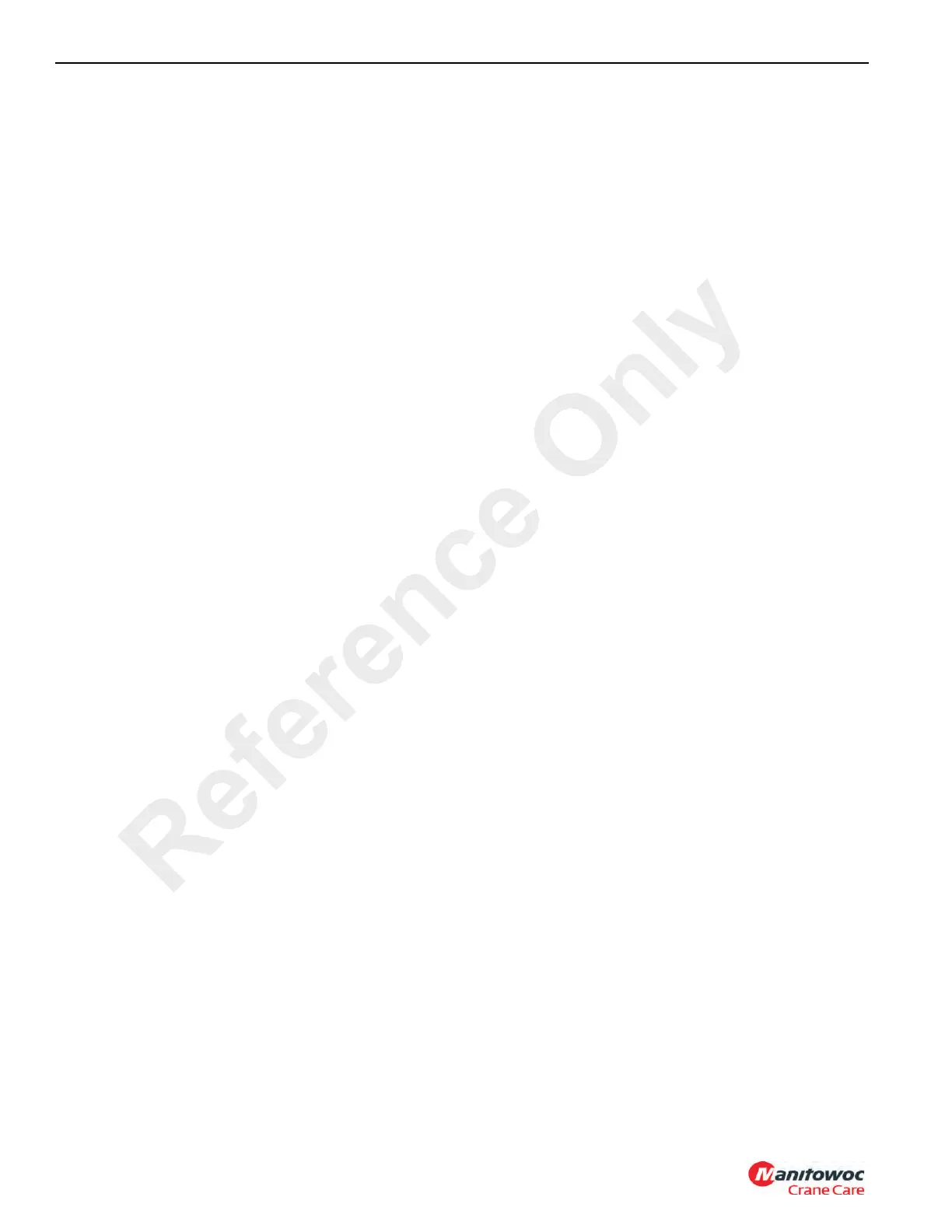BOOM RT540E SERVICE MANUAL
4-4 Published 4-20-2015, Control # 502-01
BOOM RETRACT SEQUENCE
Refer to Figure 4-1 for item location. As the telescope
cylinder is retracted, the outer mid section (6) (attached to
the cylinder barrel) and the inner mid section (4) (attached to
the inner cylinder rod) are pulled in.
During retraction the two fly and four outer mid retraction
cables are forced around sheaves (15, 19) at the rear of the
mid section. This cable arrangement keeps the fly section,
outer mid section, and the telescope cylinder in the proper
sequence and timing.
TELESCOPE CIRCUIT
Description
The boom telescope circuit consists of the telescope function
remote control, telescope directional control valve, holding
valve, and the telescope cylinder.
NOTE: If the crane is equipped with an auxiliary hoist, the
telescope function is controlled by a foot pedal
instead of a controller.
The telescope control valve is the closed spool type and is
described under Valves (pg 2-27).
Refer to Valves (pg 2-27) for a complete description of the
telescope function remote control.
The boom telescope cylinder is a two stage double acting,
rod ported cylinder. Foreign material is prevented from
entering the cylinder by a wiper seal during rod retraction. O-
ring seals prevent internal and external leakage. Refer to
Cylinders (pg 2-54) for a complete description of the
telescope cylinder.
The holding valve is threaded into a port block on the inner
rod end of the telescope cylinder. The holding valve
functions during the retraction, extension, or holding
operation. When holding the boom section at a given length,
oil is trapped in the cylinder by the holding valve. Refer to
Holding Valves (pg 2-40) for a complete description of the
holding valve.
Theory Of Operation
Flow from the pump travels to the telescope directional
control valve. Movement of the control lever for telescope
functions from neutral sends a pilot pressure signal to the
directional control valve to shift the spool in the directional
control valve. This aligns the appropriate passages in the
control valve to route oil to the telescope cylinder holding
valve. The holding valve, with its internal make-up of valves
and springs, passes oil to and from the telescope cylinder.
During extension, oil unseats the poppet (check) valve in the
holding valve. This oil is routed to the piston sides of the
cylinder which forces the rods out of the cylinder, causing the
boom section to extend.
During retraction, oil enters the retract port and flows to the
rod sides of the cylinder. When pilot pressure reaches a pre-
determined value, the main poppet unseats, and oil flows
from the piston sides of the cylinder to the reservoir causing
the boom section to retract. All return flow from the
directional control valve goes to the reservoir.
LIFT CIRCUIT
Description
The boom lift circuit consists of the lift function remote
control, lift directional control valve, holding valve, and the lift
cylinder. These components enable the boom to be raised or
lowered to various degrees of elevation ranging from -3 to
+76 degrees from horizontal.
The lift directional control valve is the closed spool type and
is described under Valves (pg 2-27).
Refer to Valves (pg 2-27) for a complete description of the lift
function remote control.
The lift cylinder is the double acting type. Dirt and other
foreign material is prevented from entering the cylinder and
causing internal damage by a wiper seal during rod
retraction. Oil seals on both the piston and cylinder head
prevent internal and external hydraulic oil leakage. Refer to
Cylinders (pg 2-54) for a complete description of the lift
cylinder.
The holding valve is a balanced poppet type hydraulic valve.
It is threaded into the port block which is an integral portion of
the lift cylinder barrel. The holding valve functions when
booming up (cylinder rod extended), booming down (cylinder
rod retracted), or holding (cylinder rod stationary).
A velocity fuse is installed in the RCL piston transducer port
of the lift cylinder port block. The velocity fuse is used to
prevent inadvertent retraction (lowering) of the lift cylinder
should the line to the transducer develop a leak. The fuse will
close when flow reaches 11.4 L/min (3 gpm).
Theory Of Operation
The directional control valve bank housing the lift control
valve is supplied by flow from the hydraulic pump.
When booming up, oil unseats the poppet (check) valve in
the holding valve, letting oil flow to the piston side of the
cylinder. Pressure is applied to the piston, forcing the rod to
extend, raising the boom.
When booming down, oil enters the retract port of the port
block and flows to the cylinder rod side. When pilot pressure
reaches a pre-determined value, the main poppet unseats
and oil flows from the piston side of the cylinder to the
reservoir.
All return flow from the control valve goes to the reservoir.
Reference Only

